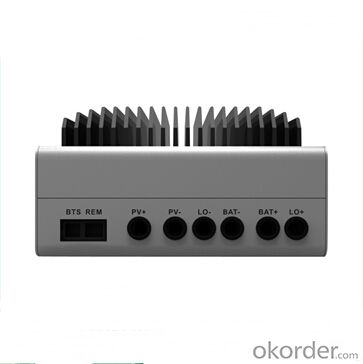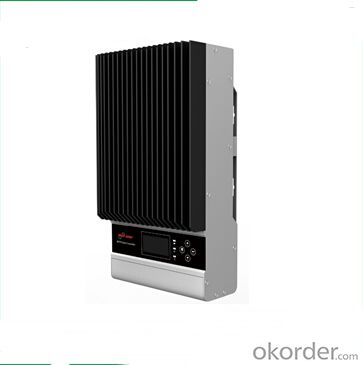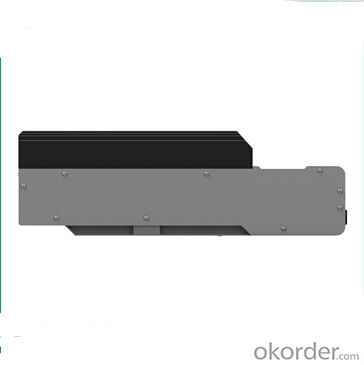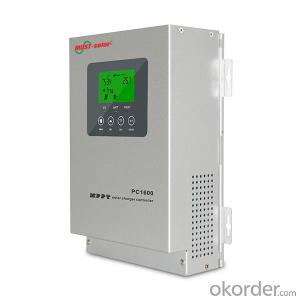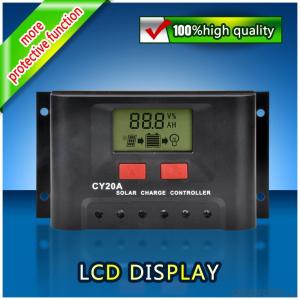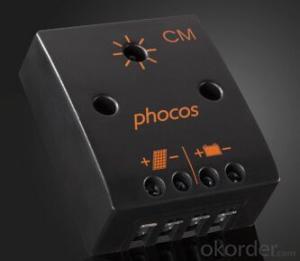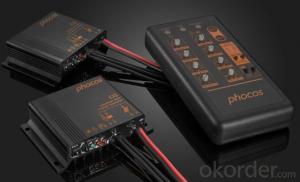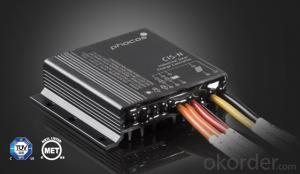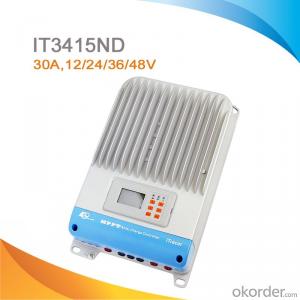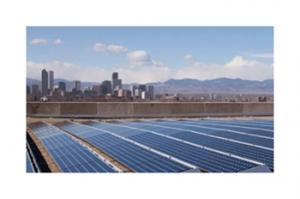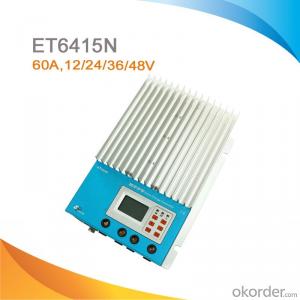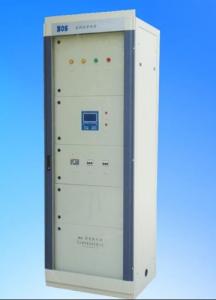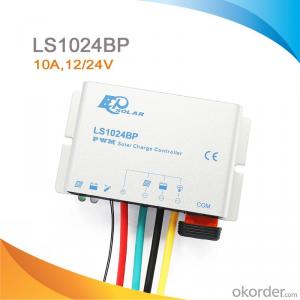Solar Geyser Thermal Controllers PC1600F Series Solar Charge Controller
- Loading Port:
- China Main Port
- Payment Terms:
- TT or LC
- Min Order Qty:
- -
- Supply Capability:
- 10000 unit/month
OKorder Service Pledge
OKorder Financial Service
You Might Also Like
Product Description:
Features:
45A/60A MPPT Solar charge controller
PV input :145V Max
12V/24V/36V/48V auto work
MPPT efficiency>99%,Peak conversion efficiency >98%
DSP processors technology ensure high speed and performance
Four-stages charging mode
Protection: PV array short circuit , PV reverse polarity , Battery reverse polarity , Over charging , Output short circuit
Model | PC1600-1 | PC1600-2 | |
Battery System Voltage | 12V/24V/36V/48 VDC (adjustable) | ||
Charge Input | |||
PV Open Circuit Voltage | Operational max = 145VDC temperature corrected VOC | ||
Max PV Input Power(12V) | 600W | 800W | |
Max PV Input Power(24V) | 1200W | 1600W | |
Max PV Input Power(36V) | 1800W | 2400W | |
Max PV Input Power(48V) | 2400W | 3200W | |
Battery Voltage | |||
Nominal Voltage | 12VDC/24VDC/36VDC/48VDC | ||
Absorption Voltage | 13.5VDC/27.0VDC/40.5VDC/54.0VDC | ||
Refloat Voltage | 13.7VDC/27.4 VDC/41.1VDC/54.8VDC | ||
Float Voltage | 14.3VDC/28.6 VDC/42.9VDC/57.2VDC | ||
Low Voltage Protection Point | 10.5VDC/21.0 VDC/31.5VDC/42.0VDC | ||
DC Output | |||
Output Voltage | 11.0~14.3VDC/22.0~28.6VDC/33.0~42.9VDC/44~57.2VDC | ||
Max Charging Current | 45A amps continuous @ 40°C ambient | 60 amps continuous @ 40°C ambient | |
Warning for low voltage | 11.5VDC/23.0 VDC/34.5VDC/46.0VDC | ||
Cutoff for low voltage | 10.5VDC/21.0 VDC/31.5VDC/42.0VDC | ||
Low voltage recovery | 11.5VDC/23.0VDC/34.5VDC/46.0VDC | ||
Display | |||
LED indication | Systematic operation, LV indication, LV protection, over charge protection, loads protection, short circuit protection | ||
LCD display | Charge voltage, charge current, voltage of battery, capacity of battery, output current | ||
Alarm | PV array short circuit protection, PV reverser polarity protection | ||
Battery reverse polarity protection, Over charging protection | |||
Output short circuit protection | |||
Low voltage protection for storage battery | |||
General specification | |||
Environmental Rating | Indoor | ||
Charge mode | MPPT, PWM, constant current—constant voltage, function of automatic protection for storage battery | ||
Radiating mode | Fan cooling | ||
Working mode | Four stage: Absorption CC, Absorption CV, Float CC, Float CV. | ||
Peak Conversion efficiency | 98% | ||
Environment | |||
Environmental temperature | -25°C ~55°C | ||
Ambient humidity | 0--90%,No condensation | ||
Altitude | ≤3000m | ||
Dimension | |||
W*H* D(mm)/G.W(kg) | 167.6*257.1*82.9mm/3kg | 390*365*364mm(5pcs/carton) | |
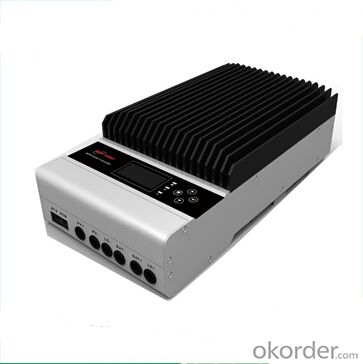
Warrenty
provides a 1~3 year limited warranty (“Warranty”) against defects in materials and workmanship for its Uninterruptible power supply, Power inverter/chargers, Solar charge controllers, Battery Products (“Product”).
The term of this Warranty begins on the Product(s) initial purchase date, or the date of receipt of the Product(s) by the end user, whichever is later. This must be indicated on the invoice, bill of sale, and/or warranty registration card submitted to MUST-Solar. This Warranty applies to the original MUST-Solar Product purchaser, and is transferable only if the Product remains installed in the original use location.
FAQ:
Q1. What is the voltage?
A1. Our 45/60A solar charge controller is 12/24/36/48V auto work.
Q2. What is the difference between MPPT&PWM?
A2. MPPT has higher efficiency, it can track the max power point and won't waste energy.
Q3. What is the efficiency of the MPPT controller?
A3. MPPT>99%, peak conversion efficiency>98%.
Q4. What is the waranty of product?
A4. 12 months.
Q5. What protection does your MPPT controller have?
A5. PV array short circuit, PV reverse polarity, Battery reverse polarity, Over charging, Output short circuit.
- Q: What is the maximum output current for a solar controller?
- The maximum output current for a solar controller depends on its specifications and design. It can vary widely, ranging from a few amperes to several hundred amperes, depending on the controller's intended use and the size of the solar power system it is designed to support.
- Q: What is the efficiency of a solar controller?
- The efficiency of a solar controller refers to how effectively it converts and regulates solar energy for use in a solar power system. It is typically expressed as a percentage and represents the amount of solar energy that the controller can efficiently capture and deliver to the connected load.
- Q: What is the maximum warranty period of a solar controller?
- The maximum warranty period of a solar controller can vary depending on the manufacturer and the specific model. Generally, solar controllers come with warranty periods ranging from 1 to 5 years. However, some high-quality controllers may offer warranties of up to 10 years or more. It is important to check the product specifications and warranty information provided by the manufacturer to determine the exact maximum warranty period for a particular solar controller.
- Q: Can a solar controller be used in a solar-powered electric train system?
- Yes, a solar controller can be used in a solar-powered electric train system. A solar controller helps regulate the flow of electricity from the solar panels to the train's battery system, ensuring efficient charging and preventing overcharging. It also protects the batteries from damage due to voltage fluctuations. Therefore, incorporating a solar controller is essential for the proper functioning and optimization of a solar-powered electric train system.
- Q: How does a solar controller prevent undercharging of batteries?
- A solar controller prevents undercharging of batteries by regulating the amount of charge that is delivered from the solar panels to the batteries. It monitors the battery's voltage and temperature, and adjusts the charging process accordingly to ensure that the batteries receive the optimal amount of charge without overcharging or undercharging.
- Q: Can a solar controller be used with a solar-powered internet connection?
- Yes, a solar controller can be used with a solar-powered internet connection. A solar controller is designed to regulate the flow of energy from solar panels to a battery, ensuring efficient charging and preventing overcharging. In the case of a solar-powered internet connection, the solar controller would manage the energy flow from the solar panels to power the necessary components of the internet connection system, such as routers or modems.
- Q: How does a solar controller handle battery equalization?
- A solar controller manages battery equalization by periodically applying a higher voltage to the battery bank, typically during a specific charging cycle. This process helps to balance the charge levels across individual batteries within the bank, preventing overcharging or undercharging of any specific battery. By equalizing the battery charge, the solar controller improves the overall performance and longevity of the battery bank.
- Q: How does a solar controller handle battery over-discharge protection?
- A solar controller handles battery over-discharge protection by monitoring the voltage level of the battery. When the voltage drops below a certain threshold, the controller will automatically disconnect the battery from the solar panel to prevent further discharge. This helps to prolong the battery's lifespan and prevent damage from excessive discharge.
- Q: Can a solar controller be used in extreme weather conditions (high winds, heavy rain, etc.)?
- Yes, a solar controller can be used in extreme weather conditions including high winds and heavy rain. Most solar controllers are designed to be weather-resistant and can withstand a range of outdoor conditions. However, it is always recommended to follow the manufacturer's instructions and take necessary precautions to protect the solar controller from any potential damage during severe weather events.
- Q: What is the float charging mode of a solar controller?
- The float charging mode of a solar controller is a maintenance mode that keeps the battery at a fully charged state, preventing overcharging while allowing for a slow and steady trickle of power to compensate for any self-discharge.
Send your message to us
Solar Geyser Thermal Controllers PC1600F Series Solar Charge Controller
- Loading Port:
- China Main Port
- Payment Terms:
- TT or LC
- Min Order Qty:
- -
- Supply Capability:
- 10000 unit/month
OKorder Service Pledge
OKorder Financial Service
Similar products
Hot products
Hot Searches
Related keywords



